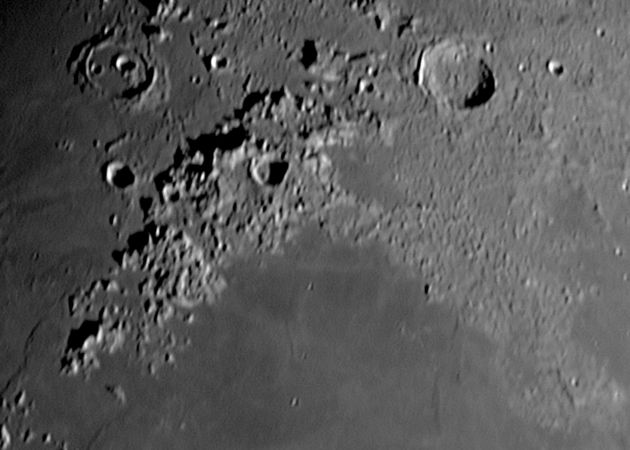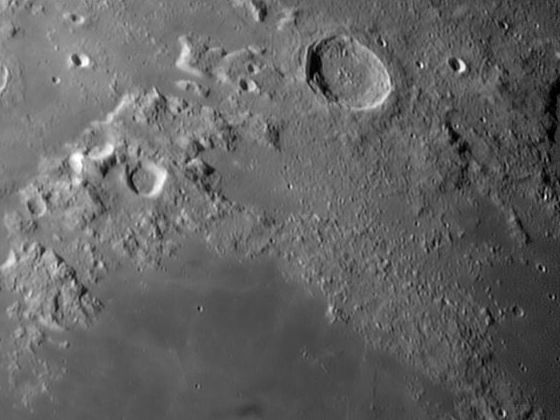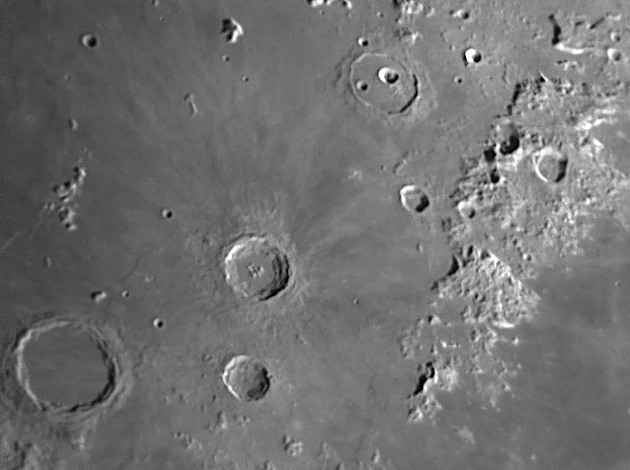Montes Caucasus 
Move your mouse over the picture to see the names of the various craters.

|
These are the Caucasus Mountains which are the northern part of the division between Mare Imbrium and Mare Serenitatis. They rise to 3 or 4 Km and look like a battered old chain of mountains. They do not appear to be part of the rim of either the Imbrium or the Serenitatis basin, but the USGS have labelled them as Imbrium ejecta. Calippus is a 33 Km wide, 2700 metre deep crater that sits atop the mountains and is similar in many respects to Theaetetus which is 25 Km wide and 2900 metres deep. Both have a polygonal shape and rough floors. Cassini is an interesting crater. It is 57 Km across but its rim rises to only 1200 metres at its highest. Presumably it post-dates the creation
of the Imbrium basin but pre-dates its flooding as lava has filled Cassini. But one can see that the floor is not smooth, maybe the result of the creation of Cassini A and B.
The scale markers are approximately 50 Km north and west.
The picture was taken with a ToUcam attached to my LX200 on 19th December 2004 at 18:00 UT,
when the Moon was 8.4 days old.
Date and Time: 19th December 2004 18:00 UT
Camera: ToUcam 740K
Telescope: LX200 at prime focus
Capture: K3CCDTools. High gamma, 1/250", 9% gain, 320 frames
Processing: Registax. 58 frames stacked. Wavelet 1-3 = 10, histogram 0-200, gamma 1.2, contrast 80
|

|
And here is a slightly larger picture of the northern part of the Caucasus Mountains with the light coming from the other direction. The most prominent crater is Eudoxus, 70 Km in diameter with steep, high walls with terraces. The floor is rugged with several central mountains.
The picture was taken with a ToUcam attached to my ETX125 with a X2 lens attached on 4th September 2004,
when the Moon was 19.9 days old.
Lunar Phase: 72.3°
Colongitude: 24.7°
Libration: +6° 56' in latitude, -7° 49' in longitude
Date and Time: 4th September 2017 04:24 UT
Camera: ToUcam 740K
Telescope: ETX125 with X2 lens
Capture: K3CCDTools. High gamma, 1/50", 20% gain, 335 frames
Processing: Registax. 195 frames stacked. Wavelet 1,2 = 10
|

|
Here the Caucusus mountains are at the top with the 85-Km crater Archimedes at the bottom. This picture is one of a set of 5 that form a mosaic from Copernicus along the Apennines to the Caucases, which may be seen here.
The picture was taken with a DMK camera attached to my LX200 on 27th December 2017,
when the Moon was 8.8 days old.
Lunar Phase: 72.3°
Colongitude: 24.7°
Libration: +6° 56' in latitude, -7° 49' in longitude
Date and Time: 27th December 2017 19:10 UT
Camera: DMK 21AF04
Telescope: LX200-10
Capture: ICCapture. 1/618", gain 727, 1800 frames
Processing: Registax6. 13 alignment points, 100 frames stacked per point. Wavelet 1,2 = 5, gamma 1.3
Focus Magic focus 2 pixels
|
Home Back to NE Quadrant




